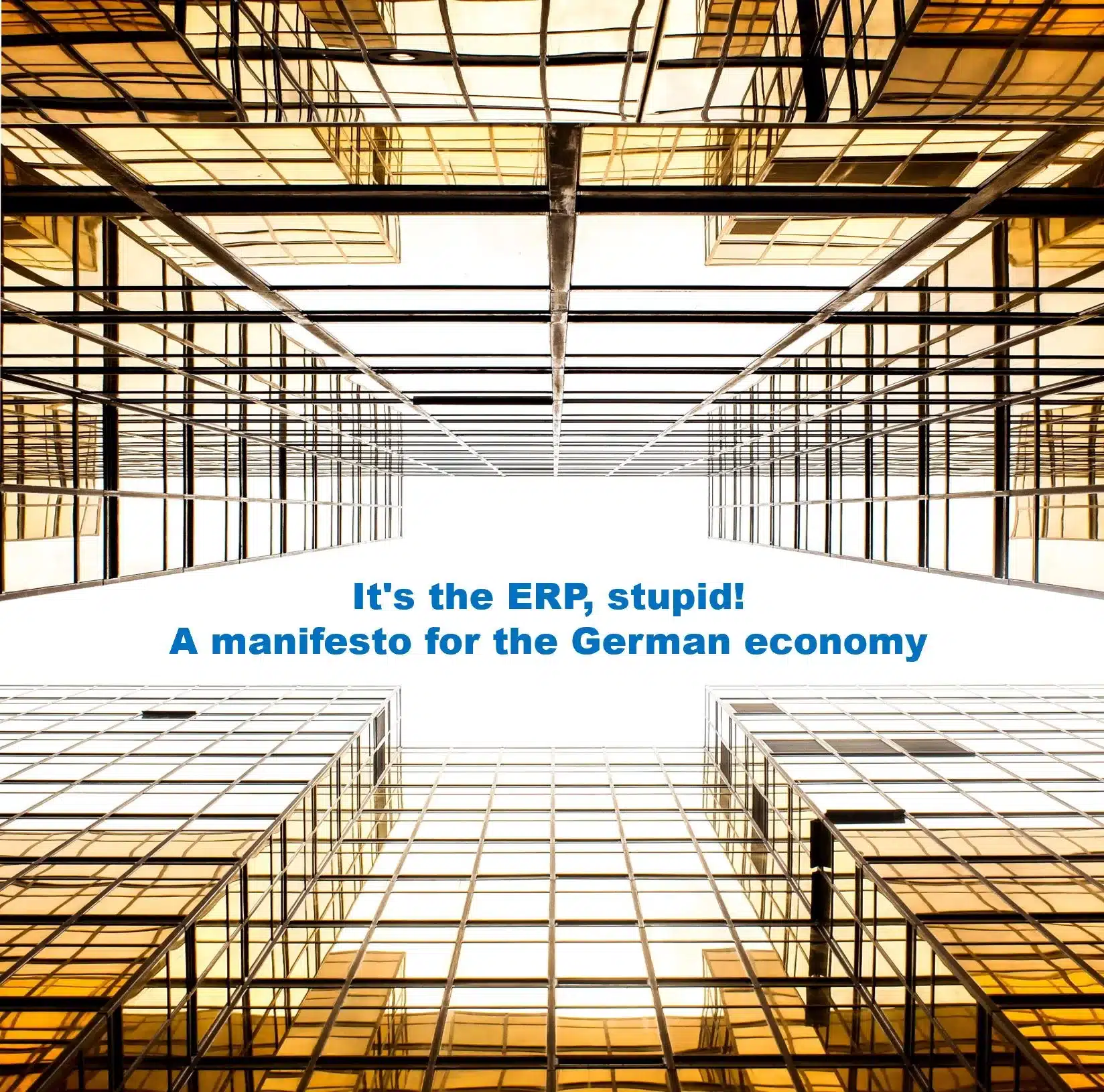In 2027, Germany missed the opportunity for digital transformation with SAP S/4 HANA
We have a dream…
It’s 2027 – and German industry is regarded worldwide as the avant-garde of Industrialisation 4.0! German mechanical engineering has fully exploited the opportunities offered by digitalisation and has long been more competitive than its Chinese rivals. The business is humming. And we are innovative! Because we have the space for it. German engineers love their jobs again, universities are training experts again and not just MBAs, German entrepreneurs are proud to make their contribution to a healthy and social society.
How did this happen?
A jolt went through the country in 2022. The visionaries of German industry woke up from the coronavirus nightmare and saw the SAP S/4 HANA migraine right in front of them. And the digitalisation overload, and the reorganisation of global supply chains, and…
Enough was enough. It was time to clean up. But where to start?
We had an idea…
Dear entrepreneur, dear CEO,
Is your company running on SAP R/3? 2027 is making your forehead sweat? Do you already envisage endless blind work, burnt-out project managers, dissatisfied customers and wasted millions? Then why not save yourself the trouble! Instead, take the opportunity to make your company fit, create space for innovation and meaningful work for your employees and lay the foundations for meaningful digitalisation! Who knows, you might even have fun doing it and end up with some money left over for all those social projects you wish you had tackled long ago.
A beautiful dream? We know it can come true. We’ve already experienced it. We’ve been there and done it. It is possible. And no, it doesn’t come for free. But the key is not in the money you throw in, on the contrary. It lies first and foremost in the fact that you personally have to make it your most important project. A crystal-clear priority. There is no other way.
We hope that as many of you as possible will now say “Do it! Where are we going? ” – because we believe in German industry, which is full of experts. We believe that these experts need to be allowed to do things again instead of spending their valuable time filling out Excel spreadsheets. We believe that many German companies have, through their own fault, created shackles that massively prevent them from realising their full potential. (Despite everything, we are still world market leaders in many areas). Now imagine what else we could do if our best experts didn’t have to spend what often feels like 70-80% of their working time doing nothing! And yes, that’s true.
If you are one of those who have to implement SAP S/4 HANA in the next few years, you have a choice: either you simply let it run its course with the probable result that you will massively increase the blind performance in your company again, destroy loyalty among employees and customers and run the risk of having to throw the whole project on the scrap heap after massive investments – or you use it as THE FUTURE OPPORTUNITY for your company (and no, we don’t get any money from SAP for this)
So what to do?
Through sweat to the stars in 12 steps:
1. If at all possible, start 2 years earlier – clean up first!
Bring all processes in the company up to date, to best practice. Look for waste! Everywhere! No mercy! Give yourself the 2 years. Above all, think about your master data. This is usually one of the biggest risk factors.
2. set a crystal-clear goal and make it your most important project
The CEO has to drive it. No one else can. It hurts. It calls everything into question. Waste is also based on unresolved conflicts and power issues.
3. build a true high performance team
Your best experts and connoisseurs. All full-time. Out and into a top-notch project office – platform-supported collaboration, fully digitalised. Clear mandate, top team lead, solid training in Enterprise Configuration Architecture & Digital Transformation for everyone!
4. have a dashboard built and look at it every morning
The CEO observes. Even then, many problems solve themselves. They clear away blockages. Immediately.
5. get targeted help from experts
If you need help, get it, it’s worth it. Ask SAP about functionality. The ERP developers have spent years defining the processes in this way and no other; it makes sense. For everything else in the transformation, get a kyona coach to make your people smart and build them up in a targeted manner.
6 Here we go: The first thing to go is the finances – the change now drives itself…
You can have full real-time transparency of all figures in the company. On your smartphone. Updated daily! This solves many other problems, simply because everyone knows that you know. You become capable of dialogue again. You can say goodbye to PowerPoint…
7. now a process, then integrate one after the other
then one process by team at a time, give examples of useful integration effects. This is how the project can be managed!
8. keep your leadership team in the driver’s seat throughout the S/4 HANA-triggered transformation
Whoever hands over the lead to the IT integrator is betrayed and sold out. Claim management then becomes extremely expensive and stress is inevitable. The lead is with you, with the CEO, the management of the initiative remains internally with your experts, if necessary you get kyona coaches to make your people fit for your project and support them at the front. But never give the lead to an external organisation.
9. liberate your co-entrepreneurs!
Remove reactive power, remove reactive power,… You have been looking for waste for at least 2 years now. You are probably already noticing that productivity is increasing or long-simmering problems are disappearing. Perhaps you have already been able to infect your fellow entrepreneurs. Use the time you have gained for real dialogue, create space for experts, allow pet projects to flourish or send your top people to exciting events.
10. celebrate – you’ve gone through PowerPoint withdrawal!
Never use PowerPoint again, except for communication tasks. You and your management team now have all the data at your fingertips. Board meetings are now just a click away. You can use the time gained for real dialogue. A party would be appropriate now. And you can think about what you can do with all the money you’ve saved – maybe call the mayor?
11 The ERP is running, digitisation can come
Now you have clear processes. You have an overview. The standard business is running. If you still have energy, it’s time to move on: you automate what makes sense to automate (don’t forget the know-how issue!) – and you start a company-wide game that helps you look for good ideas for digitalisation (drones to check stock levels? New digital business models? Completely new customer services?) Now you can (explain) that. You can also simply think about how you can bring more fun into the company…
12. …
Conclusion
These at least eleven points show once again very clearly that an ERP implementation is not an IT project, but rather a challenge for the entire organisation. It is not primarily the enterprise resource planning software itself that leads to the failure of large ERP projects, but rather the “trappings” in terms of the eleven points mentioned.
If we really want to tackle the digitalisation of German companies and reap the benefits, expertise must be built up within the company. This is only possible with teams of top experts who are fully digitalised themselves and have clear expectations communicated by management.
I hope that you will take these ten points to heart before starting the project and thus create a solid foundation for a successful ERP implementation.After all, it is important to prepare well and correctly and to have an overarching vision of the enterprise resource planning project.This is the only way to give the ERP project a sense of purpose and thus provide motivation to persevere until the successful go-live, even in difficult phases.
About the Author:
Rainer Borg
After 10 years of consulting and development work in a large auditing and management consultancy and as the CEO of a start-up, Rainer Borg dedicated himself entirely to the topic of Scaled Agility Collaboration in organisational and product development.
With profound competence in Scaled Agility Enterprise architectures, he dimensioned agility in SAP triggered Digital Transformations from the individual team to the entire group of companies.
His passion is to accompany companies in their change, to initiate structures that enable the management to manage the complexity of change initiatives like SAP S/4 HANA rollouts and to master and control it. On the other hand, to enable employees to get involved and actively shape the company.
* e.g. Computerwoche 21.01.2021
- November 29, 2023
- Rainer Borg
- kyona GmbH



